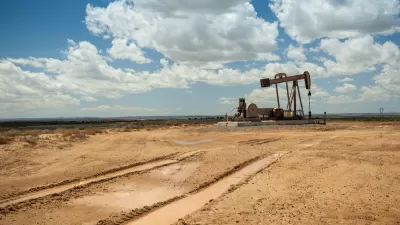Tioga County, Pennsylvania provides lessons of a post-oil-boom economy.

Laura Legere tells the story of Tioga County on either side of the Marcellus Shale boom. Since the boom, according to Legere, residents and businesses "have generally adjusted to the natural gas industry’s downward swing with equanimity."
A key characteristic of Tioga County's story is that the "drilling boom started and subsided earlier — and more abruptly — than other nearby counties and across the state." From 2008, the number of shale wells blossomed from 15 to 276 by 2010. Now the number is back down to 17.
But the county has proven resilient.
The Tioga County Development Corp. released an analysis of the lingering impact of Marcellus Shale development on the county’s economy in the summer of 2015 and found that total employment in the county was almost identical in 2014 to what it was in 2007 — although in the intervening years it had experienced gains (a 12 percent increase between 2009 and 2012) and dips (a 5 percent drop between 2007 and 2009, and another 6 percent drop between 2012 and 2014).
The article takes several angles to explain Tioga County's actions both during the boom and since. One of the keys to Tioga County's success, according to some of the locals: not changing too much to accommodate the boom.
FULL STORY: After Marcellus Shale boom, picturesque Tioga County resumes quieter life

Planetizen Federal Action Tracker
A weekly monitor of how Trump’s orders and actions are impacting planners and planning in America.

Maui's Vacation Rental Debate Turns Ugly
Verbal attacks, misinformation campaigns and fistfights plague a high-stakes debate to convert thousands of vacation rentals into long-term housing.

Restaurant Patios Were a Pandemic Win — Why Were They so Hard to Keep?
Social distancing requirements and changes in travel patterns prompted cities to pilot new uses for street and sidewalk space. Then it got complicated.

In California Battle of Housing vs. Environment, Housing Just Won
A new state law significantly limits the power of CEQA, an environmental review law that served as a powerful tool for blocking new development.

Boulder Eliminates Parking Minimums Citywide
Officials estimate the cost of building a single underground parking space at up to $100,000.

Orange County, Florida Adopts Largest US “Sprawl Repair” Code
The ‘Orange Code’ seeks to rectify decades of sprawl-inducing, car-oriented development.
Urban Design for Planners 1: Software Tools
This six-course series explores essential urban design concepts using open source software and equips planners with the tools they need to participate fully in the urban design process.
Planning for Universal Design
Learn the tools for implementing Universal Design in planning regulations.
Heyer Gruel & Associates PA
JM Goldson LLC
Custer County Colorado
City of Camden Redevelopment Agency
City of Astoria
Transportation Research & Education Center (TREC) at Portland State University
Jefferson Parish Government
Camden Redevelopment Agency
City of Claremont





























